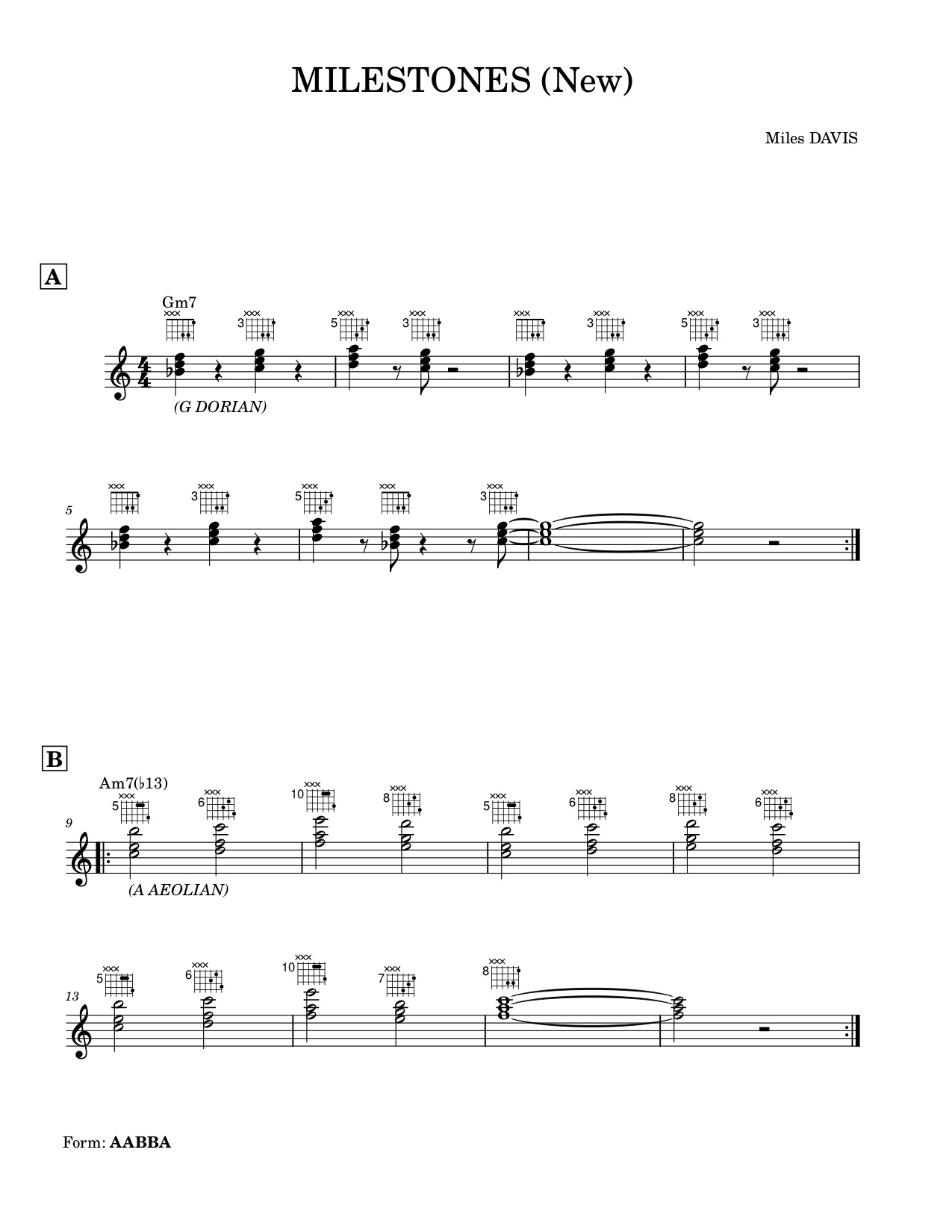"MILESTONES":
We will be talking here about the so-called "new Milestones" written by Miles Davis in 1958 -- as opposed to the "old Milestones" which was written in 1947 by John Lewis (even though it is often also credited to Miles Davis).
"Milestones" is considered a Modal composition where each 8-measure section only contains 1 chord.
The form is: AABBA
A SECTION:
Gm7 (G Dorian) implying the key of F.
We can also think Gm7/C which is Csus7. In this case it is usually preferable to resolve with FMaj7 at the end of each A section (the last 2 measures). That FMaj7 may even be played as FMaj7(#11) or F Lydian.
Here are some alternative approaches for soloing over this tune:
We can start some melodic ideas with any one of the following arpeggios:
Gm, Gm7, Bb, BbMaj7, Dm, Dm7
Coupling Triads also works well here:
Gm & Am coupled will sound like: Gm(9 11 13)
Bb & C coupled will sound like: Gm7(11 13)
The next idea is the same one that I already mentioned in a previous article on "So What/Impressions" (which you can read here: "So What/Impressions"). If we want to create a less static, less modal feeling, we can generate some motion by using the concept of "chordal thinking" where we will think of either one of the following 8-measure chord progressions while improvising:
1. | Gm7 | Am7 | Gm7 | Am7 | Gm7 | Am7 | Gm7 | (D7) ||
2. | Gm7 | Am7 | Gm7 | Am7 | Gm7 | C7 | FMaj7 | % ||
3. | Gm7 | Am7 | BbMaj7 | Am7 | Gm7 | C7 | FMaj7 | % ||
4. | Gm7 | Am7 | BbMaj7 | C7 | Gm7 | Am7 | Gm7 | (D7) ||
5. | Gm7 | C7 | Gm7 | C7 | Gm7 | C7 | FMaj7 | % ||
6. | BbMaj7 | Am7 | Gm7 | Am7 | BbMaj7 | Am7 | Gm7 | % ||
7. | BbMaj7 Am7 | Gm7 Am7 | BbMaj7 Am7 | Gm7 Am7 | BbMaj7 Am7 | Gm7 Am7 | Gm7 | % ||
(note that all the chords are diatonic to the key of F Major, so that we can somewhat retain the G Dorian modal sound)
All we have to do now is improvise lines that imply the designated chord changes, even if the bass player stays around Gm7 or G Dorian.
It can be easier to come up with melody lines if we think of acknowledging a chord progression, as opposed to staying with just one chord or mode throughout the entire 8 measures -- and we will most likely not get lost in the form as easily, in case we have a hard time feeling those 8 measures...
B SECTION:
Am7(b13) (A Aeolian) or Esus7(b9) (E Phrygian) both implying the key of C.
Some charts only specify Am7 but the melody clearly calls for the Am7(b13) chord because of the repeated F naturals.
Here again, we can start some melodic ideas with any one of the following arpeggios:
Am, Am7, C, CMaj7, Em, Em7
Since A Aeolian and E Phrygian have the same 7 notes (they both come from C Major, right ?) it is essentially what the bass player plays that will determine either mode. However, from a melodic standpoint we can still lean towards one sound or the other by deciding how we start our lines. The Phrygian sound is interesting because of the Suspended nature of the mode itself (it could also simply be because it starts with a m2 interval). It also allows for more contrast between the A and B section: in the order of brightness of modes, Phrygian is darker than Aeolian.
I usually don't feel a need to use the "chordal thinking" approach described above when improvising over the B section. Too much activity on both sections seems counter-effective. If anything, the B section provides even more of a release if we simply think of one mode.
For inspiration, you may want to listen to these great versions:
Miles Davis: "Milestones" (1958)
Miles Davis: "Miles In Europe" aka "In Antibes, July 1963" (w/ George Coleman, Herbie Hancock, Ron Carter, Tony Williams)
Miles Davis: "Live At The Plugged Nickel" (December 1965 w/ Wayne Shorter, Herbie Hancock, Ron Carter, Tony Williams)
Miles Davis: "Festival de Juan Les Pins, July 25, 1969" (w/ Wayne Shorter, Chick Corea, Dave Holland, Jack DeJohnette)
Bill Evans: "The Complete Village Vanguard Recordings, 1961"
Dave Liebman "Setting the Standard" (1992)
Meanwhile, here's the harmonized melody (with chord diagrams) as played on the original recording:

Download PDF
Click here for explanations on Reading The Chord Diagram Studies.
CLICK HERE FOR OTHER CHORDS STUDIES AVAILABLE in pdf format
IF YOU LIKED THIS ARTICLE, PLEASE CONSIDER MAKING A SMALL DONATION :-)
YOU CAN CLICK THE PAYPAL BUTTON BELOW AND ENTER THE DESIRED AMOUNT FOR YOUR CONTRIBUTION-- THANK YOU !
I am available for private lessons on SKYPE or FACETIME for more information on this topic, or on anything related to Jazz Guitar, Improvisation or Music Theory.
Click here for details.
See all topics from the Various Thoughts page.
Go to the Home page.
All Content © Bruno Pelletier-Bacquaert 2005 - 2015
|
